12 March, 2023
How hiking up Mount Kilimanjaro tested mental resilience and boosted gratitude
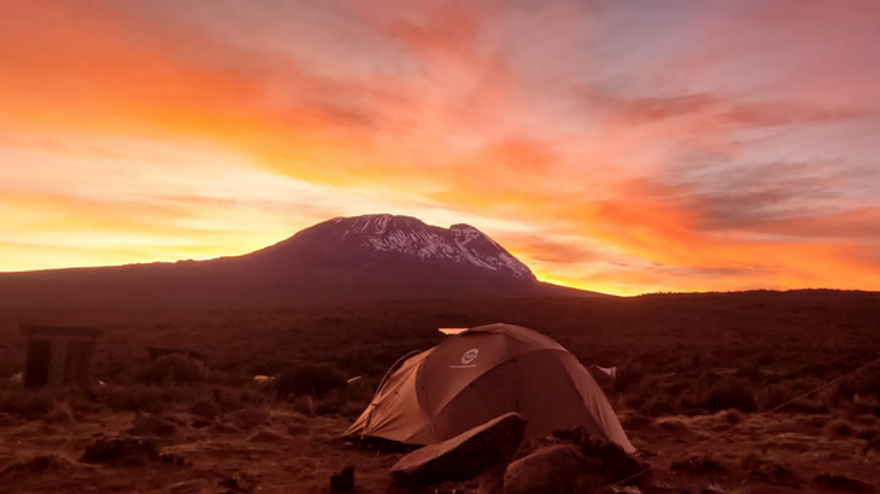
Imagine scaling the rooftop of Africa watching a slither of amber morph into a scorching red sky. As the sun births a new day, crisp white snow reveals itself on peaks, glistening like dancing fairies in the morning air. The endless mountain panorama and sheer elevation feels almost ethereal.
I had pulled off my biggest challenge yet, but everything around me was a blur. Somehow, I didn't quite feel in control of my mind or body.
The elation of hiking 48 kilometres over seven days mixed with the crushing feeling of high altitude is difficult to describe. The incredible journey trekking through the five ecological climate zones of Mount Kilimanjaro was a once-in-a-lifetime adventure.
But when I reached the top, I couldn't wait to descend.
"Yes, count me in before my ego squawks loud enough to change my mind" was my initial response to my friend's question "Anyone fancy this?"
A ten-day itinerary with eight days of trekking in Tanzania to reach and descend from Africa's highest point – one of the world's seven summits. Uhuru Peak, Mount Kilimanjaro, stands at an eye-watering 5895 metres above sea level. Technically, it’s not the steepest tip of a mountain range but the highest point of a volcano rim. And I had agreed to place my size fours on it.
The EverTrek trip sounded like a gritty outback adventure for the serious outdoor enthusiast. I could hack camping on a mountain, not showering for days, sharing a toilet with strangers and giving up first-world creature comforts. Couldn't I? I was damn well going to try!
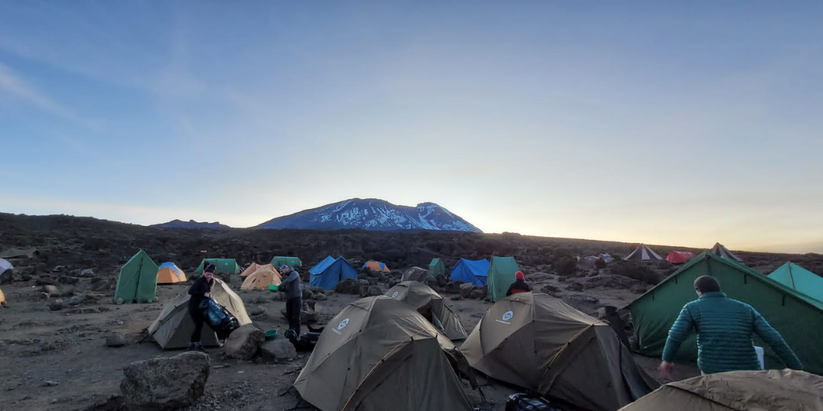
A light breeze and powder-coated runway presented the first snag. Fast forward three hours of twiddling thumbs on a grounded plane, nine hours basking on the airport floor, an unexpected flight change in Ethiopia, and we finally landed at Kilimanjaro International Airport. A day late.
Sleeping through the night was desirable, but the 24-hour operatic lungs of a rooster and regular prayer calls put paid to that. At least we had a walk-in shower and a bed in an air-conditioned room at the Springlands Hotel, Moshi.
Our first official trekking day left the dusty controlled chaos of Moshi town and welcomed open green pastures. Glimpses of giraffes, zebra and baboons roaming free prompted enthusiastic chatter on the hot, stuffy two-hour bus ride to reach Londorossi Gate, 2100 metres. The gate marks the start of the Lemosho Route at the west side of Kilimanjaro National Park.
A flavoursome hotel-packed lunch comprising green peel orange, miniature banana, jam sandwich, 'doorstop' cake, boiled egg and cooked chicken, washed down with mango juice (staple ingredients for the mountain, we would find), helped us pass the time patiently waiting for the official paperwork that allowed our guides to lead us up Mt. Kilimanjaro.
The heat of the vegetation zone, Montane Forest, would have been almost unbearable on the 7 km inaugural trek if it wasn't for the green polychrome jungle canopy. Sun cream was an absolute must, and even though applied liberally to the upper body, I suffered the consequences of missing my forearms with tender red skin followed by bubbling and flaking days later. Eew! 🤦♀️
Tree-dwelling Mt. Kilimanjaro guerezas, commonly known as colobus monkeys, with glossy black coats and majestic white mane-like tails, were a joy to spot and glimpses of green, blue and red signified the flight of social turacos birds. I'm sure I spied the metallic blue of a kingfisher before arriving at our first camp, Mount Mkubwa (which translates to ‘bug tree’), 2750 metres.
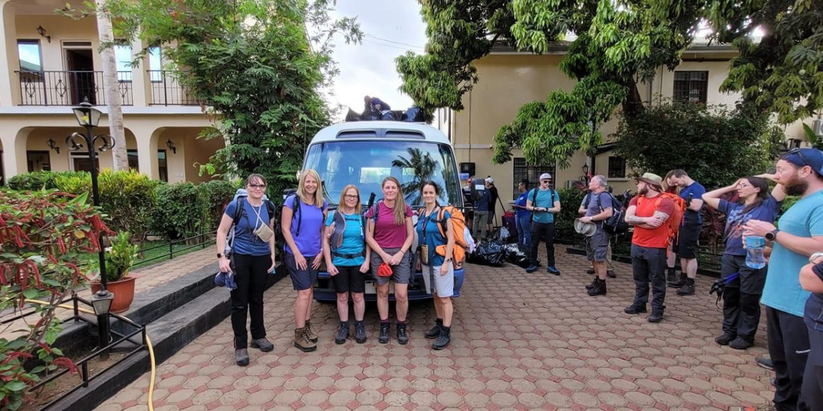
Over the next five days, we hiked higher every day and slept each night at a different camp.
I’m convinced our porters were hiding a time machine somewhere in their kit. Every morning after we left camp, they packed up six tents, two portable toilets, cooking, cleaning and serving paraphernalia, as well as their equipment, and had everything ready to welcome us at the next camp. They were the true superheroes of the trek.
Food was fresh and plentiful, with popcorn and tea snacks; soup, fruit, chicken or fish, vegetables and rice or noodles for dinner; and pancakes, omelettes, toast, fresh fruit and a range of condiments for breakfast. Hot tea or coffee was always available at mealtimes, and we had fresh water every day to ensure we drank the required three to four litres.
"Climb high, sleep low" is the mountain motto to help your body acclimatise, as is 'pole, pole' (pronounced 'poli'), a.k.a. slowly, slowly. The steady walking tempo on Mt. Kilimanjaro’s routes makes the physical motion of walking manageable. Adding variables such as 30°C+ daytime heat and minus temperatures at night, dust, dehydration, broken sleep and, not to mention, the high altitude effects present an unpredictable physiological cocktail.
A side note to anyone considering a Mt. Kilimanjaro adventure: trekking up the dormant volcano isn't considered a technical expedition. Yet, no matter how physically fit you are, acclimatisation is a balancing act our bodies must deal with and do so in different ways. Limited oxygen levels in the air impact everybody on a physiological level, especially if you live close to sea level and have no experience with high altitude.
According to the Climb Kilimanjaro Guide, the average success rate in summiting the mountain is 65%. Thankfully, the Lemosho Route has a 90% success rate because it takes eight days to follow.
Of course, climbs will inevitably become more manageable, and when you have guides who have summited 100s of times – our head guide Johnny stopped counting at 500! – you know you're in safe hands.
Hakuna matata (no worries), we took it all in our stride.
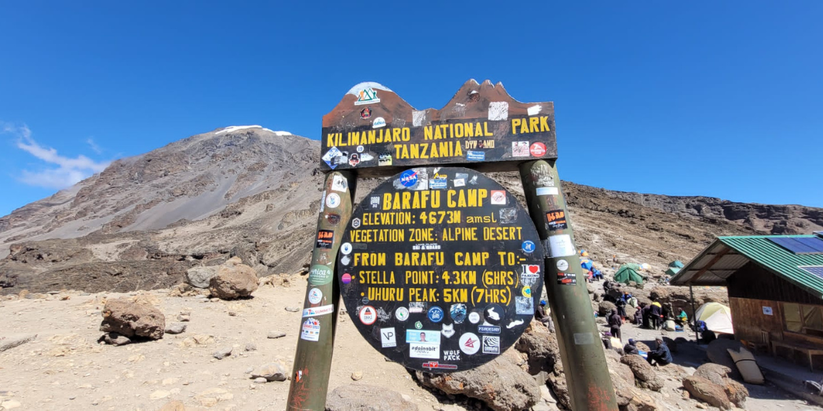
Fatigue and bodily aches started to take their toll around day four. It wasn't the terrain but rather the daily accumulation of hiking with a heavy backpack and intensifying acclimatisation.
Waves of emotion caught me by surprise at about the same time. One minute I'd be having a conversation and the next, the thought of calling my parents after summiting would have me sniffing behind my snood. But I wasn’t alone in having unpredictable mountain moods. They swung. And they did so often.
I was grateful for the company of my fellow trekkers. My four adventure enthusiast friends and I joined two solo travellers, a young couple and three Tanzanian guides; Johnny, Lukas and Johanna.
They were a great bunch of comrades and you need like-minded folk around when taking on a challenge of such magnitude. Clambering up an African mountain five times higher than the Welsh mountain, Snowdon (my highest and only comparable mountain walk) sometimes required outside motivation.
We developed, dare I say it, a sort of ESP (extra sensory perception). We knew when to be quiet and absorb the vastness of our experience. When to offer support and encouragement if the pressure threatened to crack. But we also knew when to have a hearty belly laugh. My ponytail getting entangled in the door zip of the portable loo during high winds was one such juncture I'll never forget. Hearing Juma, a porter, ask, ‘Anna, what ‘appened?’ is etched in my memory.
We were there for each other. Sharing moments looking down on a spectacular night-time thunder and lightning storm at Baranco Camp or balanced on a rocky ridge above the clouds at Cathedral Point will be cherished evermore.
On day seven, at midnight, we left the base camp, Barafu Hut, bracing against a biting side wind and temperatures of around -10°C. The five hours before spent tossing and turning as high winds battered all sides of our two-person tent wasn’t nearly enough rest (I couldn’t call it sleep) to feel alive and ready for what lay ahead. But it was what it was.
Enthusiastic anticipation and uncertain trepidation played table tennis in my mind and belly. This was the day that mattered. All the days counted, but this was the pinnacle. Literally.
Thoughts of what I was about to put myself through were overwhelming. I'd worked hard playing the narrative of celebrating at the peak and fist-pumping the air at the spot that marks the summit. I’d invested in a hypnotherapy session and a personalised meditation audio file as mental training. But my fear of altitude sickness threatening my chances of success was rising and I had to quash the rising dialogue bile.
Counting backwards from 100 helped. As did repeatedly listing girls' and boys’ names from A to Z, fruits, vegetables and meats from A to Z, animals and birds from A to Z, and countries, counties and cities from A to Z. It was the only way I could occupy my mind and stay free from my ego trying to keep me safe by flooding unhelpful thoughts of 'what if you don't make it'.
We trudged upward steadily for six hours. I could feel my limbs slowly losing strength as fatigue and limited oxygen took hold. I felt delirious and not in complete control of my body. It's how I'd imagine an out-of-body experience or at least a partial one. I saw my feet plodding, stumbling occasionally, but I couldn't feel much except for a thick head and Jack Frost gripping my fingers. Johnny had taken my poles because my hands were too cold to hold them.
'Drink and blow into your hydration tube after you've finished' was frequent advice shouted by our guides over the howling winds. It was good advice. Blowing helped prevent the water from freezing in the tube, but I stopped taking their advice in my hazy state. Partly because I had zero energy and partly because I had a thermal hydration pack and insulated tube. Why would I need to blow?
How wrong could I be? My water froze about three quarters of the way up.
Thank goodness for the hot sugary tea our guides were carrying. It was the best-tasting drink ever! Especially after a 'duck down and wee’ break, experiencing the intense shock of massaging 0°C hand sanitiser into my already cold hands. I remember thinking, 'was this how the caning punishment at school would have felt?'.
Always pack common sense on a mountain trek!
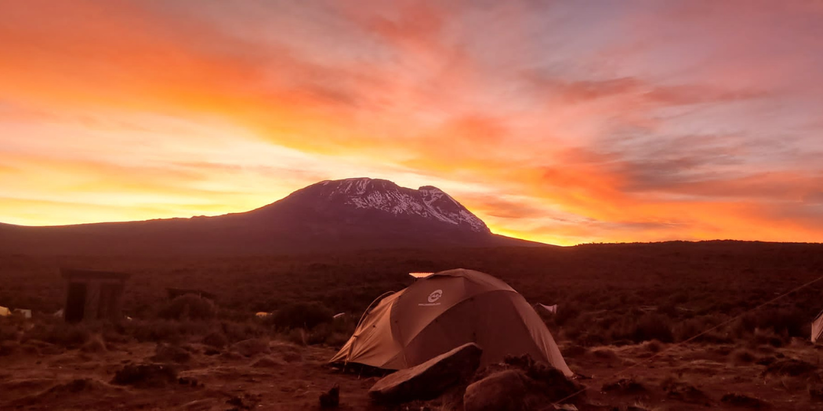
It took six hours and a gruelling 4.3 km uphill climb to reach Stella Point, 5756m. It was still dark, and a faint ochre glimmer teased sunrise. I'd done it—three cheers to me and the hundreds of other people near me at the break of dawn. I was ecstatic. Then I realised it was another kilometre before reaching the summit, Uhuru Peak.
As tired and incoherent as I felt, giving up was not an option. 'It is what it is' was becoming my mountain mantra. Though many elements of this trip were out of my control, I could control my thoughts and keep my feet moving. Left, right. Left, right. Left, right. Hanging on to 'I can do this' pushed me on.
Our Mountain Climbing Certificates from the conservation commissioner officially log our summit at 6:57 am. I wish they hadn't reminded me of my age in bold black letters!
We waited our turn to have the customary photo beside the wooden summit sign, almost blinded by the rising sun. A moment to be cherished. A once-in-a-lifetime snapshot. I couldn't wait to retreat to camp.
Trekking uphill for seven hours was exhausting, but gravitating for three more almost immediately after was just as demanding. As my faculties returned and the nausea subsided, it was comical how many times I fell backwards trying to navigate the volcanic scree.
Gobbling a salted caramel Trekbar and gulping mango juice was the best welcome back Barafu Hut base camp could have offered. After wrenching off my boots, outer socks, liner socks and peeling off my many layers, slumber engulfed me. I was knackered.
A couple of hours later, it was downhill again for four hours to reach our final camp, Mweka Hut, 3100m. While I was happy to be walking through the different vegetation zones again and feeling the oxygen replenishing my lungs, sadness filled my thoughts.
My quest was over. That night, in the jungle, I slept the best in over a week.
Sipping chilled orange Fanta from a glass bottle, perched on a cool stone bench under a gigantic parasol, in 30°C heat was heaven. A few more minutes for the paperwork to be signed and our certificates to be printed and we would be homeward bound, back to Springlands hotel.
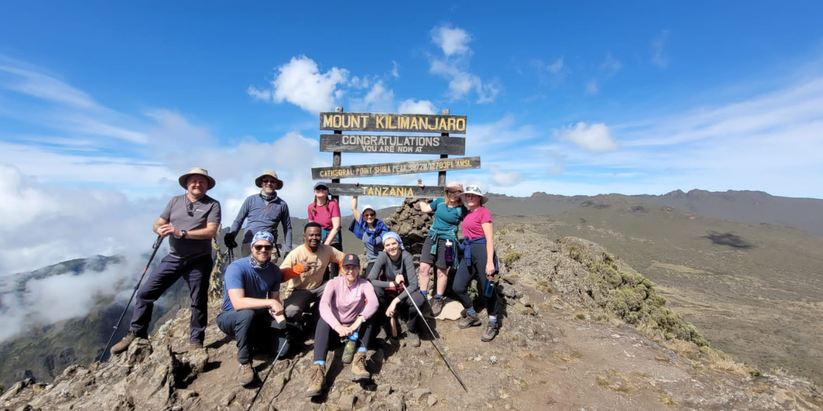
Adventure travel: I’m hooked
The experience was one hell of a forever memorable adventure. I would recommend the experience to anyone, with a few cautionary recommendations:
I feel hugely privileged to have triumphed over my 'Kili' expedition with relatively few complications. I can affectionately call it Kili now I've conquered it and it's my friend. Not everyone can raise their hand to signal having stood on the largest free-standing mountain rise in the world.
*All distances and times are approximations.
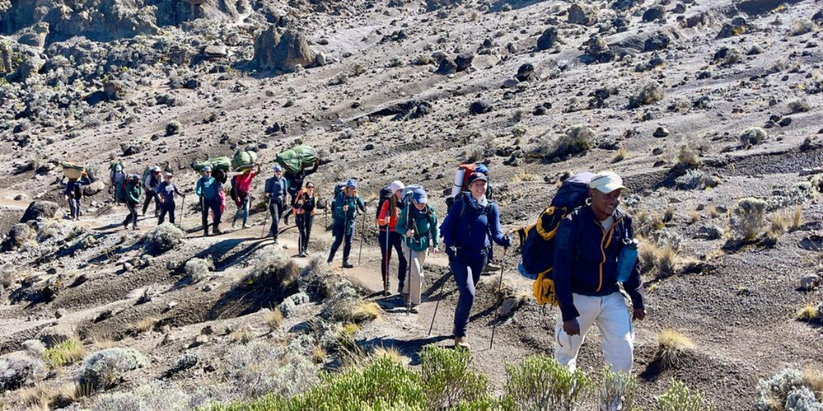
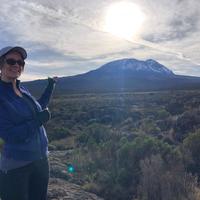
My name is Anna and I love the great outdoors!
Most recent articles in HIKING

The Ramblers, Britain’s walking charity, bring their successful Out There Award to England, empowering 18-26 year olds to embrace the outdoors with confidence.

Looking for some motivation to get you excited and active for 2024? The Beacons Challenge, taking place on Saturday 6th July 2024, may well just be that rewarding opportunity you’ve been waiting for.

Exploring the great outdoors with your dog is a fantastic way to bond and keep both of you active. You can find suitable activities for any breed, whether splashing in the surf at the beach, trekking through scenic hiking trails, or scaling mountain peaks. Therefore, this article explores the best outdoor activities, providing tips and safety advice to ensure a fun and memorable experience.